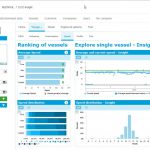DNV GL developed a new web-based performance monitoring platform. Here the module for hull and propeller of ECO Insight is described, pointing out the importance of good data and good hydrodynamic model in line with the coming ISO 19030.
For almost three decades, performance monitoring has remained an elusive issue outside the limelight of mainstream ship operation. This has[ds_preview] changed recently due to several game changing developments:
– IMO introduced in 2013 the SEEMP (Ship Energy Efficiency Management Plan) as mandatory for all ships. Monitoring the effectiveness of measures for increased energy efficiency is one of its four elements. The first year after introduction brought a sobering realization for many ship operators: our traditional monitoring systems fall short in terms of accuracy and insight.
– The increased fuel prices combined with low freight rates brought an end to previously more lenient business relationships between charterers and owners. A surge in claims questioning contractual performance brought both owners and charterers to measure and assess more closely the performance of ships, avoiding disputes through more accurate monitoring for both sides. Similarly, coating manufacturers and suppliers of energy saving devices have an interest in demonstrating measurable savings to their customers.
– The proposal of a new ISO standard for hydrodynamic performance of ships in service, ISO (2014), stimulated additional discussion and illuminated short-comings of older performance monitoring systems. The open discussion with international panels of experts brings more transparency and comparability of performance monitoring methods. DNV GL has taken an active role in furthering these goals from the beginning.
ECO Insight – Modular fleet performance management
Today, a large variety of operational data is commonly collected on board ships, including noon reports, snapshot reports, voyage reports, bunker reports, and real-time data recorded by systems. Data is often sent ashore by e-mail and then stored in the office with only superficial analysis. Only in cases of obvious inconsistencies or large outliers action is taken or detailed analyses are performed. With only small modifications to this process, data from reports can be utilised for continuous Fleet Performance Management, allowing ship operators to create transparency throughout their operations and develop significant fuel-savings measures.
Fleet Performance Management aims at improving ship performance based on insight from operational data. ECO Insight follows a flexible and scalable approach based on modules, and it covers all major ship performance topics such as voyage and vessel performance as well as engine and systems performance. We focus in the following on hull and propeller performance.
Hull performance monitoring – A keystone technology
Performance monitoring of ships is by no means new to the industry. Jensen and Söding (1985) present one of the first attempts for an on-board hydrodynamic monitoring system. Grabellus (1990) of Hamburg-based ship operators Hamburg-Süd expanded on their work for a voyage optimization advisory system based on data collected regularly on board ships in operation. Grabellus determined the ship performance solely based on on-board data, using statistical regression techniques. Voyage legs on shallow water in port approaches were not evaluated. Many data were acquired automatically, some had to be added manually. The system was abandoned after some years, due to frequent sensor failure and overall disappointing accuracy.
The subsequent decades have seen assorted variation on the theme, varying in details, but overall sharing a similar approach. Progress in sensor technology, hydrodynamic modelling and processing of large amounts of data offer possibilities today, that did not exist 30 years ago.
All performance monitoring systems have a similar basic approach: raw data acquired on board are filtered and corrected for external influences. The corrections are based on engineering models which differ in sophistication, accuracy and required effort. Errors in the resulting hull performance rating stem thus from two main sources:
– Input data error: On-board sensors have inherent limited precision. The crew is also a »sensor« in this sense, adding errors due to faulty estimates, deliberate lies or reporting errors. Speed through water is a notorious example for sensor-based errors. : »Although the speed log is one of the oldest sensors on board ships, it is still one of the most inaccurate instruments and it does not give the speed through water with an acceptable accuracy«, write Boom et al. (2013).
– Model errors: Models are by definition approximations of reality. Some influence factors are omitted for convenience, making the model faster and easier to handle. Other factors may be approximated, for example using »representative« or »average« semi-empirical estimates derived from many ships, thus by nature not exact for an individual ship. Neglecting trim and using cruse model-test based interpolation for the effect of draft on required hull power are typical model errors in most performance monitoring systems. Container vessels are particularly sensitive to such modelling errors. Model test results typically cover only two load conditions (design and sea trial), and only a small speed range near design speed. Power requirements are extrapolated for lower speeds and interpolated for intermediate draft and trim values between the speed-power curves for design and sea trial conditions. Even for tankers, average errors of 7% are added by this popular, but dangerously crude model approach (Bertram and Lampropoulos, 2014).
The more you know, the faster you learn
While each tool must have an engineering or hydrodynamic knowledge base, the chosen approach to generate this knowledge base decides costs and accuracy of the software. There are two fundamentally different approaches to derive performance monitoring systems.
The first approach is based on system identification of the actual ship. Typically some machine learning techniques are employed which perform in essence the task of putting smooth »curves« through data. The more parameters are involved and the more random scatter the data has, the slower the computer learns. For example, ambient conditions introduce unavoidable scatter in data. Typically, machine-learning systems must be exposed to an initial dedicated training period varying key parameters (such as draft, trim and speed for hull performance) during days where the ambient conditions do not contaminate the data sets too much (»sea trial conditions«). After that, it is life-long learning to fill missing patches in the knowledge base and updating existing knowledge. This continuous learning is called »dynamic« in marketing jargon.
The second approach uses insight into physics and advanced simulation techniques to feed the knowledge base. The advantage of this approach is that there is no random ambient contamination. Simulations allow systematic and complete investigations of possible operational conditions, also for rare and extreme occurrence. The disadvantage is that any model is only an approximation of reality. If models are validated, i.e. prove to be accurate against precisely measured data, this approach is superior to system identification in terms of speed and cost, sometimes also in terms of accuracy.
In practice, the best approach uses insight in physics and advanced simulations as far as possible to build the knowledge base and reduce remaining system tuning to a minimum. The more knowledge is furnished in the beginning, the faster and better machine learning approaches can fill the gaps. In short, the more you know already, the faster you learn the rest.
Building on long experience with on-board measurements and advanced engineering, DNV GL has developed software to support the shipping industry focussing on three key pillars:
– User-friendliness – minimize the input for users, especially for on-board systems; use intuitive displays; display key information only for quick access using with pull-down menu for added options and information on demand.
– Transparency – document underlying engineering models and system identification approaches in publications, often with peer review; we strive to use the best possible approaches and believe that transparency is crucial to build trust.
– Accuracy – using data checking at the source, adapted filtering and calibration combined with advanced simulation techniques, performance monitoring systems can be made significantly more accurate.
The Navigator Performance software is the backbone for subsequent business intelligence analyses using ECO Insight. Navigator Performance collects data using a stringent »enter data once only« philosophy. The system then uses input data for assorted reporting tasks to different stakeholders (owners, operators, authorities, cargo owners, etc.), reducing the administrative workload for the crew significantly. According to DNV GL, ECO Insight uses these data to track performance of hull, propeller, machinery and main consumers. The development roadmap for ECO Insight foresees the addition of further data sources, such as AIS data, fuel analytics data, weather data and other sources to enhance performance management and benchmarking possibilities.
A pilot project demonstrated how ECO Insight generates tangible benefits in practice. DNV GL processed reported data for an operator with a fleet of nine chemical/product tankers. The speed-performance evaluation revealed large differences between the individual vessels. By closely monitoring the average speed and waiting times through ECO Insight, the overall average speed could be reduced without changing schedules, with an associated fuel saving of 3% just from this single measure.
Through transparency to savings
The accuracy of performance monitoring depends on the quality of the data input, the sampling frequency and the quality of the engineering model for the corrections of changing ambient and operational conditions. Trend monitoring supports management decisions on daily operation and maintenance strategies. The key to unlocking dormant saving potential lies in shared transparency between all stakeholders, including on-board crews. A new generation of DNV GL services and software tools were developed to support these performance monitoring tasks, incorporating stringent data re-use for user-friendliness and cutting edge simulation technology for accuracy.
Dr. Volker Bertram



















